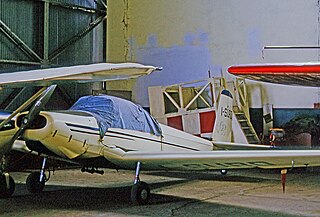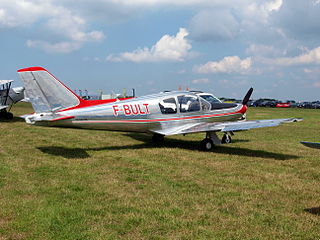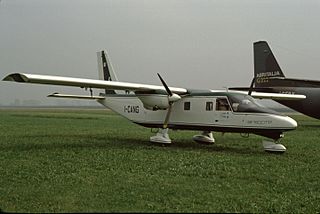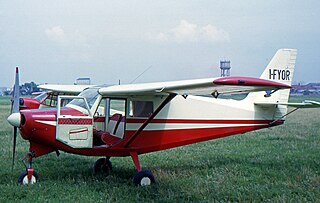Related Research Articles

The Partenavia P.68, now Vulcanair P68, is a light aircraft designed by Luigi Pascale and initially built by Italian Partenavia. It made its first flight on 25 May 1970, its type certification was granted on 17 November 1971 and was transferred to Vulcanair in 1998. The original six-seat high-wing monoplane is powered by twin piston engines and is used for light transport and training. The P.68 Observer is an observation aircraft variant, and it was developed in a stretched, 10/11-seat twin turboprop derivative.

The Agusta A.104 Helicar was an Italian prototype light commercial helicopter first flown in December 1960.

The Alaparma Baldo was an unusual two-seat light monoplane produced in Italy shortly after World War II. Designed by Adriano Mantelli, it featured an egg-shaped fuselage with cabin doors that hinged upwards and to the back. The conventional tailplane with single fin and rudder was carried on twin booms, either side of a pusher engine installation. The undercarriage consisted of a single mainwheel under the fuselage pod, a small tailwheel not far behind it, and outrigger wheels on the wingtips.

The Partenavia P.64B/P.66B Oscar is an Italian two/four-seat, single-engined, high-wing monoplane built by Partenavia.

The Aviamilano P.19 Scricciolo was a light civil trainer aircraft built in Italy in the 1960s.

The Breda A.9 was a biplane trainer produced in Italy in 1928 for the Regia Aeronautica. Conventional in design, it featured a single-bay, unstaggered wing cellule and fixed tailskid undercarriage. The student and instructor sat in tandem, open cockpits. A slightly smaller version, designated A.9-bis was developed for use in Italy's aeroclubs.

The FMA 20 El Boyero ("Shepherd") was a light utility aircraft produced in Argentina in the 1940s. It was a conventional high-wing strut-braced monoplane with fixed tailskid undercarriage with seating for two side by side in an enclosed cabin.

The Procaer F.15 Picchio is an Italian-designed light utility aircraft built by Procaer.

The Vulcanair SF.600 Canguro was a feederliner developed in Italy in the late 1970s. Despite a number of attempts to put the aircraft into series production, only a small number were ever built. The Canguro was a high-wing cantilever monoplane of conventional configuration with a fuselage of rectangular cross-section and a high-set tail. The tricycle undercarriage was not retractable, and its main units were carried on sponsons on the fuselage sides. SIAI Marchetti provided funding towards the construction of the prototype, and constructed this aircraft at the former Aviamilano plant. After flight testing proved positive, the type was put on sale, but failed to attract buyers in any number, even when the original piston engines were exchanged for turboprops and retractable undercarriage was offered as an option.

The Macchi MB.308, later Aermacchi MB-308, was a light aircraft produced in Italy in the late 1940s.
The Partenavia P.59 Jolly was an Italian two-seat training monoplane designed by Partenavia to meet a requirement for the Aero Club d'Italia. First fight was in 1960.
The Partenavia P.55 Tornado was a 1950s Italian high-performance competition and touring monoplane built by Partenavia. The Tornado was a small mid-wing cantilever monoplane with a retractable tricycle landing gear. The aircraft was powered by a nose-mounted Lycoming O-320 piston engine.

The Partenavia P.57 Fachiro is an Italian, four-seat, high-wing, touring monoplane, fitted with a fixed tricycle undercarriage.
The Partenavia P.48 Astore was a 1950s Italian light aircraft built by Luigi Pascale and his brother in Naples before establishing Partenavia.
The Partenavia P.52 Tigrotto was a 1950s Italian light aircraft built by Partenavia in Naples.

The Valentin Taifun is a two-seat self-launching sailplane designed and built by Valentin Flugzeugbau GmbH of Hasfurt, Germany.

The Piel CP.60 Diamant is a single-engine light aircraft designed in France in the 1960s and marketed for home building.

The Scheibe SF-25 Falke is a German touring motor glider developed from the earlier Bergfalke glider by Scheibe Flugzeugbau. Since May 2006 the business has been run by Scheibe Aircraft GmbH.
The Partenavia P.70 Alpha was a 1970s Italian two-seat light aerobatic trainer designed by Luigi Pascale and built by Partenavia.

The Partenavia P.53 Aeroscooter was a 1950s Italian single-seat light aircraft fitted with a two-bladed rotor. It was designed by Luigi Pascale with Mario de Bernardi and built by Partenavia.
References
- Simpson, R. W. (1995). Airlife's General Aviation. Shrewsbury: Airlife Publishing. p. 276.
- Taylor, John W. R. (1988). Jane's All The World's Aircraft 1988–89. Coulsdon, UK: Jane's Defence Data. ISBN 0-7106-0867-5.
- Taylor, Michael J. H. (1989). Jane's Encyclopedia of Aviation. London: Studio Editions. p. 916.